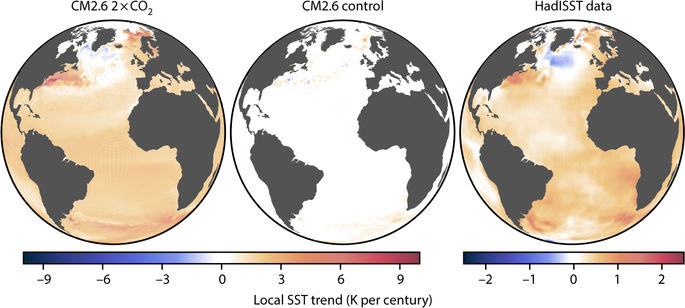Our official English website, www.x-mol.net, welcomes your
feedback! (Note: you will need to create a separate account there.)
Observed fingerprint of a weakening Atlantic Ocean overturning circulation
Nature ( IF 50.5 ) Pub Date : 2018-04-01 , DOI: 10.1038/s41586-018-0006-5 L. Caesar , S. Rahmstorf , A. Robinson , G. Feulner , V. Saba
Nature ( IF 50.5 ) Pub Date : 2018-04-01 , DOI: 10.1038/s41586-018-0006-5 L. Caesar , S. Rahmstorf , A. Robinson , G. Feulner , V. Saba

|
The Atlantic meridional overturning circulation (AMOC)—a system of ocean currents in the North Atlantic—has a major impact on climate, yet its evolution during the industrial era is poorly known owing to a lack of direct current measurements. Here we provide evidence for a weakening of the AMOC by about 3 ± 1 sverdrups (around 15 per cent) since the mid-twentieth century. This weakening is revealed by a characteristic spatial and seasonal sea-surface temperature ‘fingerprint’—consisting of a pattern of cooling in the subpolar Atlantic Ocean and warming in the Gulf Stream region—and is calibrated through an ensemble of model simulations from the CMIP5 project. We find this fingerprint both in a high-resolution climate model in response to increasing atmospheric carbon dioxide concentrations, and in the temperature trends observed since the late nineteenth century. The pattern can be explained by a slowdown in the AMOC and reduced northward heat transport, as well as an associated northward shift of the Gulf Stream. Comparisons with recent direct measurements from the RAPID project and several other studies provide a consistent depiction of record-low AMOC values in recent years.A characteristic ‘fingerprint’ of sea-surface temperatures suggests that the Atlantic overturning circulation has slowed substantially since the mid-twentieth century, as predicted by climate models in response to increasing carbon dioxide emissions.
中文翻译:

观察到减弱的大西洋翻转环流的指纹
大西洋经向翻转环流 (AMOC)——北大西洋的一个洋流系统——对气候有重大影响,但由于缺乏直流测量,它在工业时代的演变鲜为人知。在这里,我们提供了自 20 世纪中叶以来 AMOC 减弱了约 3 ± 1 sverdrups(约 15%)的证据。这种减弱是由一个特征性的空间和季节性海面温度“指纹”揭示的——由亚极地大西洋的冷却模式和墨西哥湾流地区的变暖模式组成——并通过来自 CMIP5 项目的模型模拟集合进行校准. 我们在高分辨率气候模型中发现了这个指纹,以响应不断增加的大气二氧化碳浓度,以及自 19 世纪后期以来观察到的温度趋势。这种模式可以通过 AMOC 的放缓和向北热传输的减少以及墨西哥湾流的相关北移来解释。与来自 RAPID 项目和其他几项研究的最近直接测量结果的比较一致地描述了近年来创纪录的低 AMOC 值。海面温度的特征“指纹”表明大西洋翻转环流自中期以来已大幅放缓。二十世纪,正如气候模型预测的那样,以应对不断增加的二氧化碳排放。
更新日期:2018-04-01
中文翻译:

观察到减弱的大西洋翻转环流的指纹
大西洋经向翻转环流 (AMOC)——北大西洋的一个洋流系统——对气候有重大影响,但由于缺乏直流测量,它在工业时代的演变鲜为人知。在这里,我们提供了自 20 世纪中叶以来 AMOC 减弱了约 3 ± 1 sverdrups(约 15%)的证据。这种减弱是由一个特征性的空间和季节性海面温度“指纹”揭示的——由亚极地大西洋的冷却模式和墨西哥湾流地区的变暖模式组成——并通过来自 CMIP5 项目的模型模拟集合进行校准. 我们在高分辨率气候模型中发现了这个指纹,以响应不断增加的大气二氧化碳浓度,以及自 19 世纪后期以来观察到的温度趋势。这种模式可以通过 AMOC 的放缓和向北热传输的减少以及墨西哥湾流的相关北移来解释。与来自 RAPID 项目和其他几项研究的最近直接测量结果的比较一致地描述了近年来创纪录的低 AMOC 值。海面温度的特征“指纹”表明大西洋翻转环流自中期以来已大幅放缓。二十世纪,正如气候模型预测的那样,以应对不断增加的二氧化碳排放。











































 京公网安备 11010802027423号
京公网安备 11010802027423号